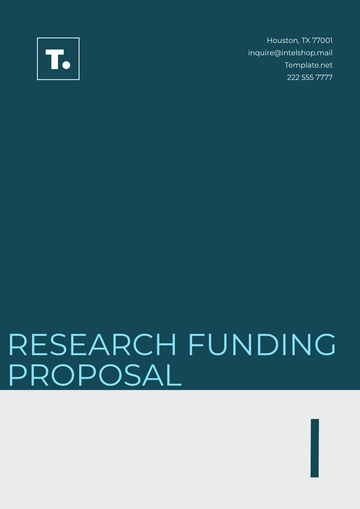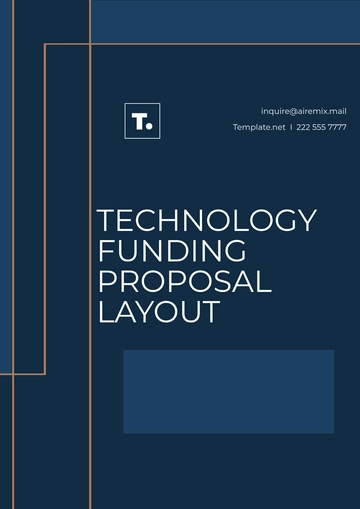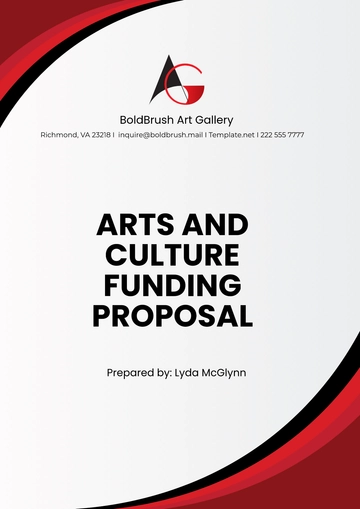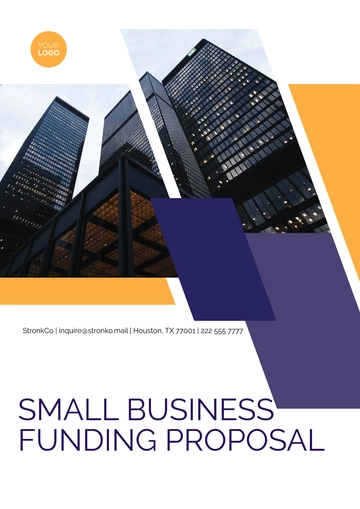Free Funding Format Proposal
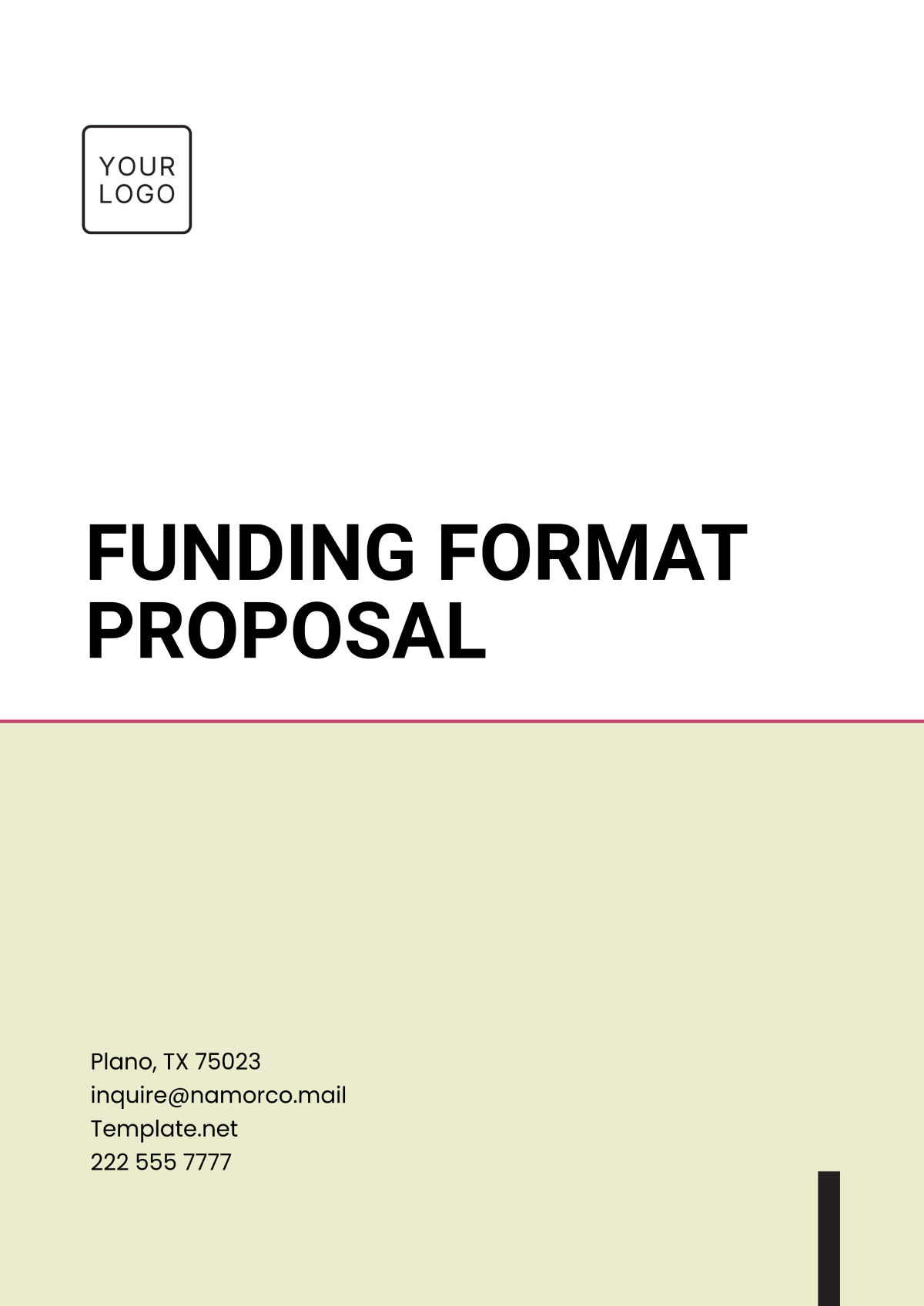
Prepared by: [Your Name]
Date: [Date]
I. Executive Summary
Purpose
The executive summary should provide a brief, yet impactful overview of the project. Clearly state the funding amount you are requesting and the objectives you aim to achieve with that funding. The summary should grab the reader’s attention by presenting the problem, your approach to solving it, and the expected results in a concise manner. Keep it under one page and ensure it is compelling to encourage further reading of the full proposal.
II. Introduction
Background Information
This section introduces your organization or team, highlighting its history, mission, and key accomplishments. Include the following:
Organization’s History: Briefly explain how your organization was founded, its core purpose, and its journey.
Mission and Vision: Clarify what your organization stands for, including the values it upholds and the long-term vision it aims to achieve.
Past Successes: Demonstrate your organization’s experience and expertise by summarizing previous successful projects or initiatives. Mention any recognition or partnerships that can enhance your credibility.
Key Personnel: Highlight the leadership and project team members, mentioning their qualifications, roles, and past contributions.
III. Problem Statement
Identify the Need
In this section, you must clearly define the problem or need that your project intends to address. This will lay the foundation for your entire proposal, so it’s important to:
State the Problem: Describe the issue in detail. Make sure the reader understands why this is a significant problem that warrants attention.
Provide Data: Support your statement with statistics, research findings, or real-world examples to validate the existence and scale of the problem. This helps build a stronger case for funding.
Explain Urgency: Convey why this problem needs to be addressed immediately. Discuss the potential consequences of inaction and why timely intervention is essential.
IV. Goals and Objectives
A. Project Goals
Define the long-term, overarching outcomes you aim to achieve with your project. Goals should be broad, visionary, and connected to the larger mission. They should serve as the guiding principles for the project and the reason behind your request for funding. Ensure that your goals align with the interests of the potential funder.
B. Specific Objectives
List measurable, tangible, and time-bound objectives that will help achieve the project goals. These objectives are the steps that contribute directly to the success of the project and should be:
Specific: Clearly define what will be accomplished.
Measurable: Include metrics or indicators to track progress.
Achievable: Set realistic goals based on available resources and capacity.
Relevant: Ensure objectives are aligned with the broader project goals.
Time-bound: Provide a clear timeline for each objective to show that progress will be regularly assessed.
V. Project Description
A. Activities
Provide a detailed outline of the main activities that will be undertaken to achieve the objectives. Break down each activity by:
Task: What specific actions will be taken?
Timeline: When will each task take place? Include key milestones.
Responsible Parties: Who will oversee or implement each activity? Be thorough in this section to convey the steps involved in successfully carrying out the project.
B. Timeline
Offer a clear timeline for the entire project, broken down into phases or milestones. This timeline should show when each phase will begin and end, helping funders understand the project’s duration and key deliverables. Make sure the timeline is realistic, achievable, and consistent with your objectives.
C. Resources Needed
Identify and explain the resources required to successfully execute the project. This includes:
Human Resources: Personnel needed, including their roles and expertise.
Material Resources: Equipment, tools, or supplies required.
Facilities: Space, venues, or infrastructure needed.
Financial Resources: Any other financial considerations, including co-funding or matching contributions if applicable. List all these resources in a way that links back to the project’s objectives and activities.
VI. Budget and Financial Plan
A. Budget Breakdown
This section should provide a detailed budget outlining how you plan to allocate the funds. Break the budget into categories (e.g., salaries, materials, travel, overheads) and provide a clear rationale for each expenditure. It should:
List All Expenses: Include direct and indirect costs, ensuring everything is accounted for.
Show How Funds Will Be Used: Explain why each expenditure is necessary to achieve the project’s objectives.
Provide a Total: Sum the total amount requested and justify the funding needed.
B. Sustainability Plan
Explain how the project will continue to deliver results after the funding period ends. Discuss:
Future Funding Sources: How you plan to sustain the project once the initial funding has been used.
Revenue Generation: If applicable, detail any self-sustaining mechanisms, such as fees, sales, or ongoing donor support.
Long-term Goals: Outline strategies for long-term impact, ensuring that the project’s results will endure beyond the initial investment.
VII. Impact Statement
A. Project Benefits
In this section, explain the direct benefits that the project will provide to the target community or population. Discuss:
Expected Outcomes: What specific changes will occur as a result of the project?
Who Will Benefit: Describe the target audience and how they will be impacted.
Significance: Explain why these benefits are valuable and how they contribute to solving the identified problem.
B. Long-Term Impact
Discuss the broader, long-term benefits of the project. This could involve:
Sustainable Change: How the project contributes to lasting change.
Scaling Potential: The ability of the project to be expanded or replicated.
Alignment with Larger Goals: How the project fits into broader societal, environmental, or economic goals.
VIII. Monitoring and Evaluation
A. Methods
Outline how the progress and success of the project will be measured throughout its duration. This includes:
Data Collection: Methods for gathering data (e.g., surveys, interviews, assessments).
Key Performance Indicators (KPIs): Metrics to measure progress (e.g., the number of people served, funds raised).
Evaluation Tools: Tools and techniques that will be used to track performance (e.g., surveys, feedback forms, statistical software).
B. Reporting and Adjustments
Describe how progress will be reported to funders and stakeholders. Include:
Frequency of Reports: How often will updates be provided (e.g., monthly, quarterly)?
Adjustments: How you will adjust the project if things are not progressing as planned.
IX. Conclusion
Summary of Request
Reiterate the need for funding and emphasize why your project deserves the requested financial support. This section should serve as a strong call to action, summarizing the goals, benefits, and expected impact of the project. Make sure it is persuasive, reinforcing the urgency and importance of the funding request.
X. Attachments
Supporting Documents
Include all relevant supporting documents that validate the project and your organization’s capacity to deliver. This might include:
Financial Statements: To demonstrate fiscal responsibility.
Letters of Support: From stakeholders, partners, or community leaders.
Resumes of Key Personnel: Highlighting the qualifications of those leading the project.
Additional Information: Any other documents that strengthen your case for funding.
- 100% Customizable, free editor
- Access 1 Million+ Templates, photo’s & graphics
- Download or share as a template
- Click and replace photos, graphics, text, backgrounds
- Resize, crop, AI write & more
- Access advanced editor
The Funding Format Proposal Template from Template.net is designed for organizations seeking funding opportunities. Fully editable and customizable, this template makes it easy to present your funding request professionally. Edit quickly in our Ai Editor Tool to fine-tune your proposal to match your project needs. Start applying for funding with this streamlined template today.
You may also like
- Business Proposal
- Research Proposal
- Proposal Request
- Project Proposal
- Grant Proposal
- Photography Proposal
- Job Proposal
- Budget Proposal
- Marketing Proposal
- Branding Proposal
- Advertising Proposal
- Sales Proposal
- Startup Proposal
- Event Proposal
- Creative Proposal
- Restaurant Proposal
- Blank Proposal
- One Page Proposal
- Proposal Report
- IT Proposal
- Non Profit Proposal
- Training Proposal
- Construction Proposal
- School Proposal
- Cleaning Proposal
- Contract Proposal
- HR Proposal
- Travel Agency Proposal
- Small Business Proposal
- Investment Proposal
- Bid Proposal
- Retail Business Proposal
- Sponsorship Proposal
- Academic Proposal
- Partnership Proposal
- Work Proposal
- Agency Proposal
- University Proposal
- Accounting Proposal
- Real Estate Proposal
- Hotel Proposal
- Product Proposal
- Advertising Agency Proposal
- Development Proposal
- Loan Proposal
- Website Proposal
- Nursing Home Proposal
- Financial Proposal
- Salon Proposal
- Freelancer Proposal
- Funding Proposal
- Work from Home Proposal
- Company Proposal
- Consulting Proposal
- Educational Proposal
- Construction Bid Proposal
- Interior Design Proposal
- New Product Proposal
- Sports Proposal
- Corporate Proposal
- Food Proposal
- Property Proposal
- Maintenance Proposal
- Purchase Proposal
- Rental Proposal
- Recruitment Proposal
- Social Media Proposal
- Travel Proposal
- Trip Proposal
- Software Proposal
- Conference Proposal
- Graphic Design Proposal
- Law Firm Proposal
- Medical Proposal
- Music Proposal
- Pricing Proposal
- SEO Proposal
- Strategy Proposal
- Technical Proposal
- Coaching Proposal
- Ecommerce Proposal
- Fundraising Proposal
- Landscaping Proposal
- Charity Proposal
- Contractor Proposal
- Exhibition Proposal
- Art Proposal
- Mobile Proposal
- Equipment Proposal
- Student Proposal
- Engineering Proposal
- Business Proposal





